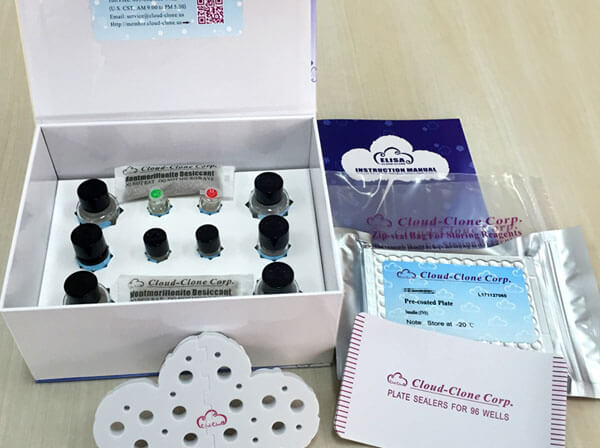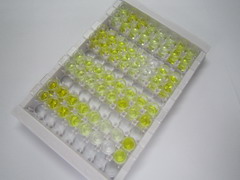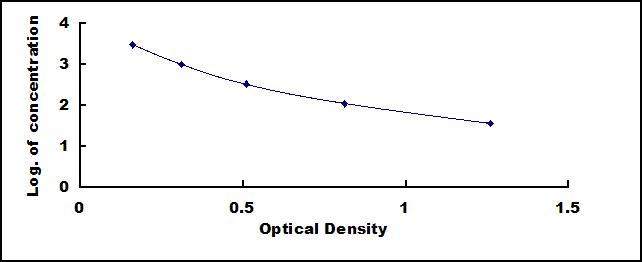ELISA Kit for Neurotensin (NT) 

NTS; NTS1; NmN-125; NN; Tail peptide Neuromedin N
- UOM
- FOB US$ 505.00 US$ 722.00 US$ 3,249.00 US$ 6,137.00 US$ 50,540.00
- Quantity
Overview
Properties
- Product No.CEB203Ra
- Organism SpeciesRattus norvegicus (Rat) Same name, Different species.
- ApplicationsEnzyme-linked immunosorbent assay for Antigen Detection.
Research use only - DownloadInstruction Manual
- CategoryReproductive scienceNeuro scienceHormone metabolism
Sign into your account
Share a new citation as an author
Upload your experimental result
Review

Contact us
Please fill in the blank.
Recovery
Matrices listed below were spiked with certain level of recombinant Neurotensin (NT) and the recovery rates were calculated by comparing the measured value to the expected amount of Neurotensin (NT) in samples.
| Matrix | Recovery range (%) | Average(%) |
| serum(n=5) | 80-104 | 97 |
| EDTA plasma(n=5) | 80-97 | 85 |
| heparin plasma(n=5) | 95-103 | 99 |
Precision
Intra-assay Precision (Precision within an assay): 3 samples with low, middle and high level Neurotensin (NT) were tested 20 times on one plate, respectively.
Inter-assay Precision (Precision between assays): 3 samples with low, middle and high level Neurotensin (NT) were tested on 3 different plates, 8 replicates in each plate.
CV(%) = SD/meanX100
Intra-Assay: CV<10%
Inter-Assay: CV<12%
Linearity
The linearity of the kit was assayed by testing samples spiked with appropriate concentration of Neurotensin (NT) and their serial dilutions. The results were demonstrated by the percentage of calculated concentration to the expected.
| Sample | 1:2 | 1:4 | 1:8 | 1:16 |
| serum(n=5) | 83-98% | 87-94% | 79-104% | 96-103% |
| EDTA plasma(n=5) | 87-104% | 81-92% | 82-105% | 97-104% |
| heparin plasma(n=5) | 80-93% | 79-89% | 97-105% | 85-99% |
Stability
The stability of kit is determined by the loss rate of activity. The loss rate of this kit is less than 5% within the expiration date under appropriate storage condition.
To minimize extra influence on the performance, operation procedures and lab conditions, especially room temperature, air humidity, incubator temperature should be strictly controlled. It is also strongly suggested that the whole assay is performed by the same operator from the beginning to the end.
Reagents and materials provided
| Reagents | Quantity | Reagents | Quantity |
| Pre-coated, ready to use 96-well strip plate | 1 | Plate sealer for 96 wells | 4 |
| Standard | 2 | Standard Diluent | 1×20mL |
| Detection Reagent A | 1 | Assay Diluent A | 1×12mL |
| Detection Reagent B | 1×120µL | Assay Diluent B | 1×12mL |
| Reagent Diluent | 1×300µL | Stop Solution | 1×6mL |
| TMB Substrate | 1×9mL | Instruction manual | 1 |
| Wash Buffer (30 × concentrate) | 1×20mL |
Assay procedure summary
1. Prepare all reagents, samples and standards;
2. Add 50µL standard or sample to each well.
And then add 50µL prepared Detection Reagent A immediately.
Shake and mix. Incubate 1 hour at 37°C;
3. Aspirate and wash 3 times;
4. Add 100µL prepared Detection Reagent B. Incubate 30 minutes at 37°C;
5. Aspirate and wash 5 times;
6. Add 90µL Substrate Solution. Incubate 10-20 minutes at 37°C;
7. Add 50µL Stop Solution. Read at 450 nm immediately.

Test principle
This assay employs the competitive inhibition enzyme immunoassay technique. An antibody specific to neurotensin has been pre-coated onto a microplate. A competitive inhibition reaction is launched between biotin labeled neurotensin and unlabeled neurotensin (Standards or samples) with the pre-coated antibody specific to neurotensin. After incubation the unbound conjugate is washed off. Next, avidin conjugated to Horseradish Peroxidase (HRP) is added to each microplate well and incubated. The amount of bound HRP conjugate is reverse proportional to the concentration of neurotensin in the sample. After addition of the substrate solution, the intensity of color developed is reverse proportional to the concentration of neurotensin in the sample.
Giveaways
Increment services
Citations
- Colonic Transit Time and Gut Peptides in Adult Patients with Slow and Normal Colonic Transit Constipationpubmed:29082242
- Inhibition of Peroxynitrite-induced mitophagy activation attenuates cerebral ischemia-reperfusion injuryPubmed:29307080
- Adipose Tissue-Derived Biomarkers of Intestinal Barrier Functions for the Characterization of Diarrhoea-Predominant IBS
- Functional analysis of gut microbiota and immunoinflammation in children with autism spectrum disordersPubmed: 31320306
- Association between Circular RNA CDR1as and Post-Infarction Cardiac Function in Pig Ischemic Heart Failure: Influence of the Anti-Fibrotic Natural Compounds …Pubmed: 32823854
- Qiliqiangxin Improves Cardiac Function through Regulating Energy Metabolism via HIF-1α-Dependent and Independent Mechanisms in Heart Failure Rats …Pubmed: 32626732
- Identification of U-shaped Curve Relation in Pro-neurotensin and Risk of Coronary Artery Disease (CAD) in Premature CAD Patients
- Effect of dobutamine on intrinsic myocardial function and myocardial apoptosis in septic rats with myocardial dysfunction
- Harmine is an effective therapeutic small molecule for the treatment of cardiac hypertrophy33785860
- Elabela gene therapy promotes angiogenesis after myocardial infarction34291565
- Renal Impairment Detectors: IGFBP-7 and NGAL as Tubular Injury Markers in Multiple Myeloma Patients34946293

















